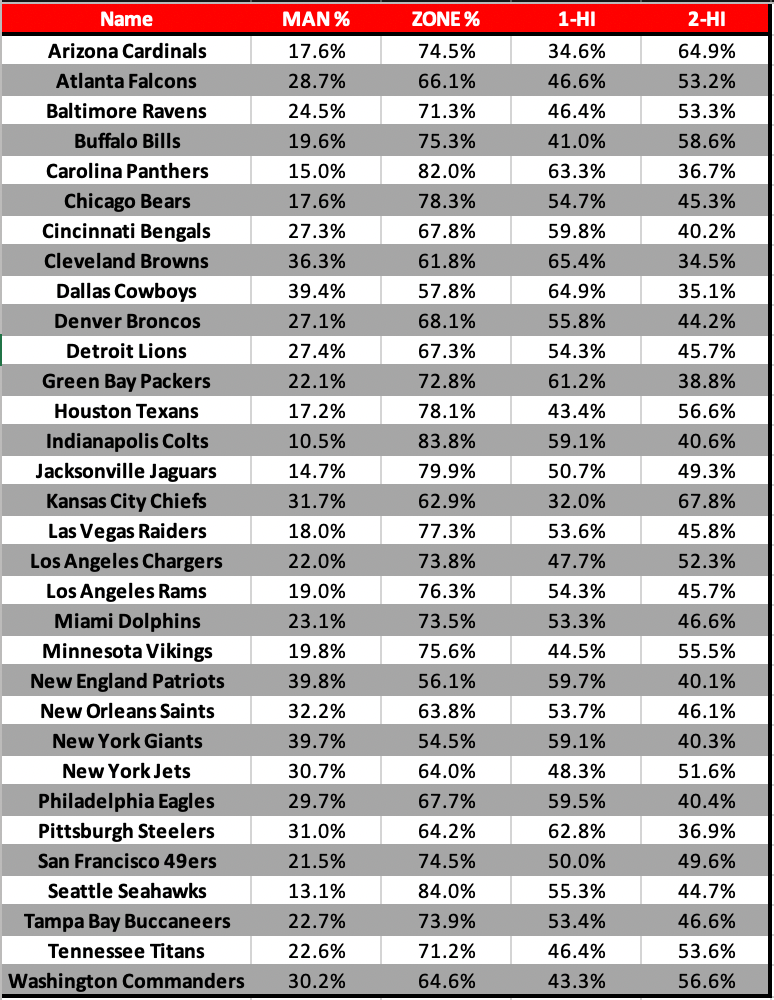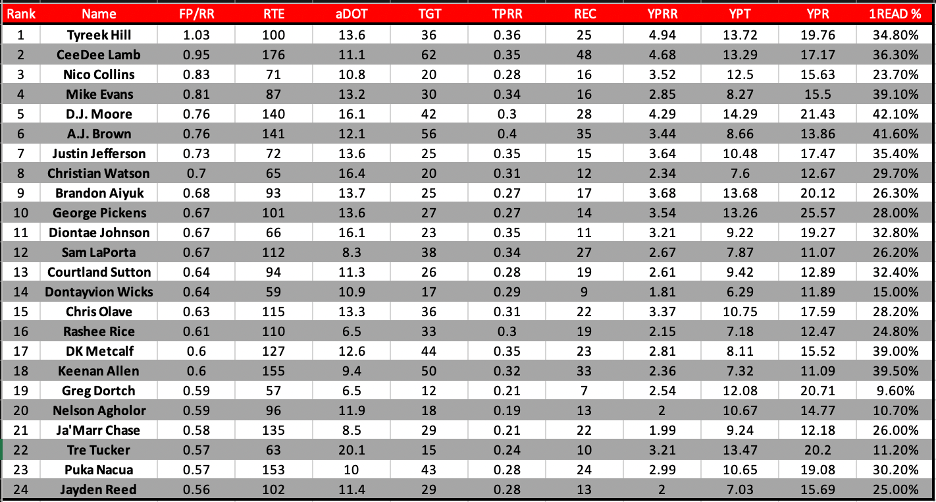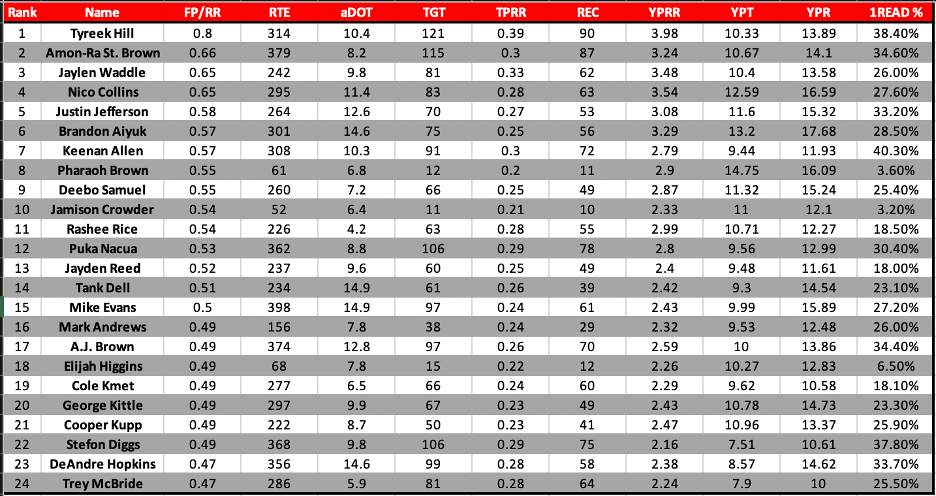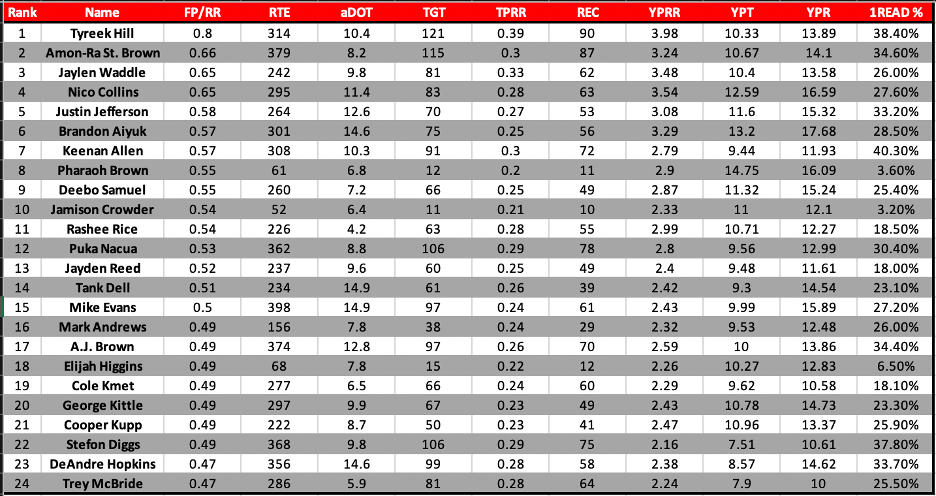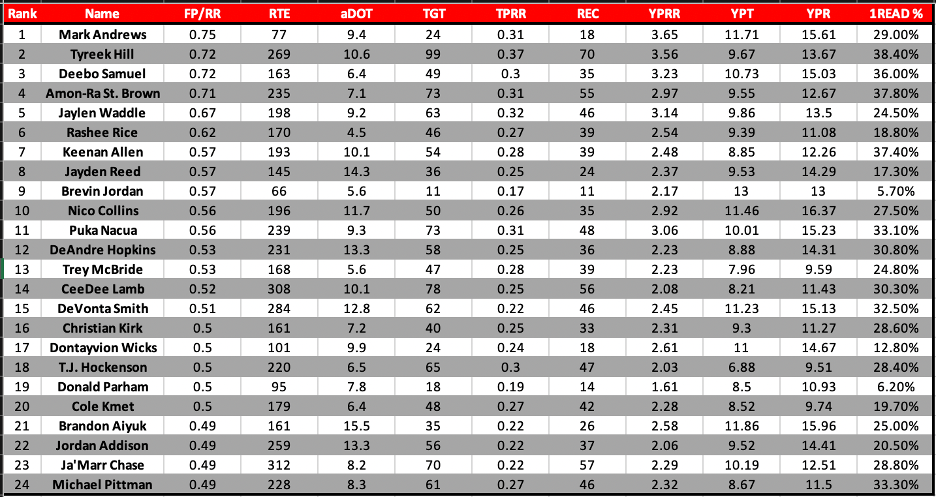Our time together in the previous two pieces was spent exploring the micro matchups that are currently being fought between offensive and defensive coordinators around the league. In this piece, we’ll take a step back to the more broad-stroke coverage shells, examining man, zone, single-high, and two-high looks.
We’re going “micro-to-macro” in this excursion for a very particular reason, which should have been evident in the preceding articles – matchups on the football field in today’s game are much more nuanced than man versus zone or single-high versus two-high. That said, there is tangible merit to quickly identifying overarching coverage trends in all facets of fantasy football gaming, leading us to finish our journey with just that. Join me as we explore wide receiver performance against man coverage, zone coverage, single-high looks, and two-high looks.
The data for this series was pulled exclusively from the Fantasy Points Data Suite. In addition, the Fantasy Points Coverage Matrix was leveraged for the league-wide broad coverage rates below.
League-Wide Broad Coverage Rates
We’ll again preface the discussion on matchup-based performance with a quick look at the rates of coverages around the league from the 2023 season.
As a quick aside, man coverage includes Cover-0, Cover-1, and Cover-2 Man while zone coverage includes Cover-2, Cover-3, Cover-4, and Cover-6. Single-high and two-high are descriptive terms alluding to the number of safeties (and their location) on the field.
The latter two are oftentimes described with more nuanced signifiers like “single-high closed” and “two-high open,” with the additional terms describing the middle of the field. For example, single-high closed simply states that the base shell includes one free safety in the middle of the field, while two-high open states that the base shell includes two free (as in, not responsible for a man in coverage, not that they play the free safety position on paper) safeties that are playing outside the hashes, generally leaving the middle of the field open.
Man Coverage
First off (and you’ve almost assuredly heard this before), the league has continued to transition to a “zone league.” The league-wide man coverage rate in the 2023 season was just 24 percent. Compare that to the 24.3 percent man coverage rate in 2022, the 27.9 percent man coverage rate in 2021, and the 30.8 percent man coverage rate in 2020. In other words, the trend is increasingly evident for a decrease in man coverage rates in the NFL.
Defensive coordinators are simply placing a higher emphasis on decreasing the likelihood of splash plays, while simultaneously bolstering the number of men in the box to combat the run.
Micro Takeaways
The above table shows the top-24 pass-catchers in fantasy points per route run (FP/RR) against man coverage from the 2023 season, of players to run 50 or more routes against man. This chart should serve to reinforce some of our findings from the previous two pieces. D.J. Moore (0.76 FP/RR, robust 16.1 aDOT, 42.1 percent first-read target rate), Christian Watson (0.70 FP/RR, robust 16.4 aDOT, moderate 29.7 percent first-read target rate), George Pickens (0.67 FP/RR, elevated 13.6 aDOT, modest 28.0 percent first-read target rate), and Sam LaPorta (0.67 FP/RR, 8.3 aDOT, modest 26.2 percent first-read target rate) jump off the page at first glance.
That said, Moore is set to play the 2024 season with a rookie quarterback and sees increased target competition from Keenan Allen and rookie Rome Odunze. Meanwhile, Pickens is set to see a new quarterback and the potential for a higher first-read target rate because of Diontae Johnson's departure this offseason. In other words, Pickens could represent an immense buy-low possibility (or early-season target in DFS against teams that utilize elevated rates of man coverage). At the same time, Moore is a potential candidate to sell.
One of the most shocking data points to come from the previous two articles was LaPorta’s successes against man coverage in his rookie season. The solid 34 percent TPRR mark is offset a bit by a modest 26.2 percent first-read target rate. Still, the underlying metrics are nothing short of elite, particularly for a tight end in his first season at the professional level. There is also still room to grow in that profile, considering the modest first-read target rate. Again, there could be significant value in fading teammate Amon-Ra St. Brown in favor of the soon-to-be second-year tight end against teams that utilize elevated rates of man coverage.
Finally, it is at least a smidge interesting that Greg Dortch finds himself on the list of the top-24 pass-catchers in FP/RR against man coverage from the 2023 season, particularly considering the Cardinals suddenly find themselves with no proven pass-catchers outside of Dortch and third-year tight end Trey McBride (yes, “proven” is carrying a lot of weight here, given Marvin Harrison Jr. is an elite prospect). The laughable 9.6 percent first-read target rate has immense room for growth, while his 2.54 YPRR value against man highlights that it was more than a fluke season for the diminutive wide receiver (those that have followed my work for any meaningful amount of time already know my unwavering enthrallment with Mr. Dortch – but yeah, the numbers, man).
Macro Takeaways
To that end, rookies historically struggle against man coverage coming out of college, which is primarily attributable to the high rate of zone coverages at the collegiate level in addition to the increased game speed in the NFL. That narrative saw a slight course correction in 2023, however, with Sam LaPorta, Dontayvion Wicks (0.64 FP/RR), Rashee Rice (0.61 FP/RR), Puka Nacua (0.57 FP/RR), and Jayden Reed (0.56 FP/RR) ending the season in the top 24 in FP/RR, amongst qualified pass-catchers. I would not consider that a trend just yet, although the incoming class of rookie pass-catchers is one of the better classes to come into the league over the previous decade. In particular, Marvin Harrison Jr and Malik Nabers have very little competition for targets against man coverage, considering the state of their respective teams.
The Dallas Cowboys, Kansas City Chiefs, Baltimore Ravens, Los Angeles Chargers, and Washington Commanders ranked in the top five in total yards against man coverage a season ago, with only the Chargers (eighth) falling outside the top five in slot target rate against man. We can draw a heavy correlation between effective slot play and overall production against man coverage in today’s NFL. Furthermore, in-line tight end target rate (8.15 percent) and running back target rate (9.43 percent) against man coverage fell well below the NFL-wide target rates at those positions.
Zone Coverage
Micro Takeaways
Tyreek Hill tops yet another list of the top performers in FP/RR against varying coverage shells. And it isn’t a case of the veteran speedster narrowly surpassing his counterparts – no, Hill is running figurative laps on the field in Miami. CeeDee Lamb at least kept the running close in efficiency metrics against man, while Hill scored a shocking 21.2 percent more fantasy points per route run against zone than any other pass-catcher in the 2023 season.
The league’s briefly anointed richest wide receiver checks in second on the list against zone from the 2023 season, as Amon-Ra St. Brown turned a corner into truly elite territory. Everything from his 0.66 FP/RR, his 30 percent TPRR, his 3.24 YPRR, and his 34.6 percent first-read target share were amongst the top five of all qualifying pass-catchers against zone a season ago, highlighting his ability to separate off the line in addition to his football IQ in identifying the soft spots in zone coverage.
Yes, the Texans added one of the top wide receivers of the previous half-decade in Stefon Diggs this offseason, but Nico Collins demands the attention of fantasy footballers after what he accomplished in 2023. He ranked in the top 10 in FP/RR against man, zone, single-high, and two-high alignments, finishing in the top three of all qualified pass-catchers against everything but two-high looks. That said, it should also be understood that Collins played over a third of the season without Tank Dell, and Diggs will undoubtedly eat into Collins’ target market share. From a broad sense, I’m of the opinion that the biggest winner of the Texans’ offseason moves is recent running back addition Joe Mixon, who should have every opportunity to see the requisite volume, red zone and goal line opportunities, and the potential for an increase in efficiency in his first year in Houston.
Say what you will about Puka Nacua, but top 24 finishes in efficiency metrics against both man and zone in his rookie season should not go unnoticed. That should be enough to merge the opinions of film grinders and the statistically inclined alike, heading into his second professional season. Moreover, the 2023 rookie managed 30.2 percent and 30.4 percent first-read target rates while playing alongside Cooper Kupp, who finished the previous season as the top producer at the position. I would also argue that there is room for growth in his 2.80 and 2.99 YPRR against zone and man, respectively – this kid is for real, with a fantasy profile primarily bolstered by his dedication, work ethic, and football smarts. I see a lot of similarities to Amon-Ra St. Brown on film, and the analytics back up that assertion.
Mike Evans continued his elite-level production into his 10th NFL season, becoming the only player in history to manage 1,000 yards receiving in 10 straight years to start a career. The analytics also showed that he wasn’t only effective against man coverage a season ago after he notched solid marks across the board against zone. Furthermore, Evans scored 13 touchdowns for the third time in the previous four seasons, all while catching passes from Baker Mayfield. Evans remains a strong selection at the two-three turn in best ball and will continue to be a staple in my DFS lineups to begin the season.
Macro Takeaways
Looking at the target rates from around the league, it becomes increasingly evident that slot wide receivers (29.92 percent target rate against zone) and running backs (18.57 percent target rate against zone) see the biggest boost in target rate against zone coverages. Inline tight ends once again lag the rest of the positions at a paltry 10.85 percent target rate. Considering the trends found against both man and zone coverages, the importance of effective slot play in today’s NFL should not go unnoticed. One of the players that sticks out the most from these trends is veteran Tampa Bay Buccaneers wide receiver Chris Godwin, who has reportedly been moved to a primary slot wide receiver role after spending 67.9 percent of his time on the field on the perimeter a season ago (compare that to his fourth-ranked 57.6 percent slot rate in 2022 and his eighth-ranked 57.5 percent slot rate in 2021).
That trend should also serve to guide our decision-making process at the tight end position, with additional emphasis placed on tight ends with heavy slot snap rates. Mark Andrews (69.7 percent slot snap rate), Dalton Kincaid (49.8 percent), Kyle Pitts (48.4 percent), Evan Engram (46.2 percent), Tyler Conklin (43.0 percent), Chigoziem Okonkwo (41.8 percent), Juwan Johnson (41.2 percent), and Travis Kelce (40.8 percent) were the only tight ends to see more than 40 percent slot snap rates in 2023. Of note, Greg Dulcich in Denver saw a 50.0 percent slot snap rate on limited playing time before suffering a season-ending injury. That last bit is particularly interesting, considering his ridiculously low ADP through early drafts.
Single-High
Micro Takeaways
There’s that Tyreek Hill dude again, just completely eviscerating the field against single-high coverages in 2023 to the tune of 33.3 percent more fantasy points per route run than the next closest player (Nico Collins). Hill should be the unquestioned WR1 off the board in best ball, but is currently taken behind CeeDee Lamb. The two are at least close in underlying metrics against man and single-high coverages, with Hill far surpassing Lamb’s production against zone and two-high looks a season ago. There is no room for debate here.
There is significant overlap in defensive principles when comparing man and single-high (although, as was covered above, the former is more directly tied to responsibilities and assignments in the secondary while the latter is more descriptive of alignment), which should help reinforce our previous findings regarding LaPorta and St. Brown in Detroit. It becomes relatively straightforward from a DFS perspective to simply target the second-year tight end against man-heavy teams and teams that utilize one deep safety in the middle of the field and St. Brown against teams that utilize heavy rates of zone coverage or two-deep safety alignments. Through the lens of best ball, stacking the two (with or without their quarterback, Jared Goff – more on this methodology in later works) should return one of the highest-floor pairings in all of fantasy land for the 2024 season.
A.J. Brown appears on all three top 24 lists to this point. He has put up consecutive 1,400-yard seasons in Philadelphia, peaking with 106 receptions for 1,456 yards and seven touchdowns last season. The fact that Brown continues to put up elite underlying metrics against various coverage schemes is a boon to his fantasy value moving forward, with the ever-present potential to finally put up elite touchdown numbers playing on the high-powered Eagles offense. The departure via retirement of Jason Kelce adds an interesting case to the upside for Brown under the assumption that the Brotherly Shove will be less effective with Kelce no longer at center.
Macro Takeaways
Reinforcing our previous findings, slot play is directly correlated to success against single-high alignments. The Miami Dolphins, Kansas City Chiefs, Buffalo Bills, Jacksonville Jaguars, and Baltimore Ravens rounded out the top five in slot target rate against single-high alignments a season ago. At the same time, the San Francisco 49ers, Houston Texans, Detroit Lions, and Dallas Cowboys joined the Dolphins in the top five in YPRR. You’ll notice that these teams represent the bulk of the forward-leaning offensive playcallers in the league today. The biggest name missing on that list is likely Sean McVay in Los Angeles, something that could be attributable to the lack of health of Cooper Kupp last season.
Two-High
Micro Takeaways
If you missed veteran tight end Mark Andrews amongst the top-24 pass-catchers in FP/RR against zone above, his performance against two-high looks in 10 games in 2023 demands notice. Andrews presents an interesting discussion heading into the new season. On one hand, we know skill position players coming off major injuries can see as much as a 30 percent drop off in efficiency the following season, typically returning to before-injury efficiency the second season after the injury.
On the other hand, Andrews has been downright dominant against zone and two-high looks over the previous three seasons. I won’t pretend to know how efficient he will be this coming season, which brings in ADP for best ball and cost versus expected ownership in DFS. At a current consensus 48 overall ADP across four major best ball sites, the price might be higher than is warranted considering his season-ending ankle injury following a controversial hip-drop tackle in mid-November. A case can be made to be underweight on Andrews in best ball while fading him earlier in the season in DFS, looking to utilize him later in the season when his salary and ownership are depressed.
Yes, Chiefs tight end Travis Kelce has caught 92 or more balls in six straight seasons, but the fact that Rashee Rice finds himself on all four of these lists is notable. From a theoretical perspective (yea, those who know me knew a bit of theory was coming at some point in this series), it makes sense to approach his situation with caution at present as his ADP is highly unlikely to climb from its current position but could fall once we hear more about his legal proceedings and subsequent discipline from the league. Just know that his underlying metrics were legitimate a season ago. In earnest, his situation is likely a substantial boost to the fantasy value of Marquise Brown. The field has taken the stance (through current ADP) that rookie wide receiver Xavier Worthy is the player that sees the largest boost in value considering Rice’s off-field issues. Still, I would venture a guess that Brown starts the season in a near-every-down role for the Chiefs — not Worthy. Brown managed a solid 24.4 percent target rate and 26 percent TPRR against single-high a season ago but has largely failed to amass elite metrics against two-high throughout his career.
Trey McBride did nothing but perform when given the opportunity in his second season. The Cardinals are highly likely to bolster their pass-catching corps with the fourth pick in the draft this season, but McBride should be able to start the season off hot, considering the lack of viable pass-catching options in Arizona (beyond rookie phenom Marvin Harrison Jr). That said, he is currently priced around Kelce, Andrews, George Kittle, and Dalton Kincaid in what has become a dead zone for tight ends. There is definite merit to bypassing this tier in favor of the volume potential found in players like Evan Engram, David Njoku, Kyle Pitts, and T.J. Hockenson, all of whom can be had much later in early drafts.
Macro Takeaways
From an “Xs and Os,” real-world football perspective, attacking two-high alignments comes down to winning on the perimeter, winning over the intermediate middle of the field, and manipulating safeties. That should place context in the list above and highlight how teams are currently looking to exploit this alignment. For example, Packers head coach Matt LaFleur has consistently found elite production against two-high looks throughout his coaching tenure in Green Bay. His Packers finished the 2023 season ranked third in YPRR against two-high looks while not overly reliant on targeting any specific area of the field. He did this through safety manipulation, invoked via pre-snap motion and layered route trees (think back to the previous two articles in this series). And then we find players like Mark Andrews, Tyreek Hill, Deebo Samuel, Amon-Ra St. Brown, and Jaylen Waddle on the list of elite players against two-high. Examining their route trees will lead back to the conclusion that players with heavy usage over the intermediate middle of the field tend to excel against two-high coverages because that’s one of the primary areas of the field with the greatest weakness from that alignment.


